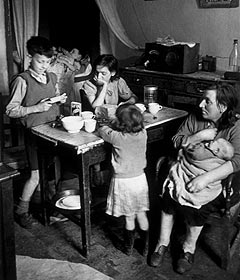Health Inequalities
There has been considerable interest in socioeconomic inequalities in health in Scotland since the end of the Second World War.
In 1937 a young obstetrician, Dugald Baird, left Glasgow to take up the chair of midwifery in Aberdeen. While working in Glasgow he was struck by the contrast between slum dwellers and upper-class women in their physique, health, and chances of maternal or infant death.
These contrasts inspired his belief in the importance of social conditions in influencing the health of women and their families, and motivated continuing efforts on his part, and that of many colleagues and successors, to study social factors in health.
In 1947 he reported that stillbirth rates had reduced markedly during the war, probably due to increased female employment and better diet, and that the rate was around two to three times higher in lower social classes than in higher social classes.
It was hoped by many that the creation of the NHS in 1948, and other aspects of the post-war welfare state, would not only improve health overall but reduce inequalities in health.
However from the mid-1970s, Baird and others such as Sir John Brotherston, Chief Medical Officer in Scotland, noted that although health indicators had improved overall since the 1920s, the improvement had been greatest in the better-off social groups and the differences between the top and bottom of the social scale had increased.
Baird showed that perinatal mortality rates in the top three social classes fell 51 per cent between 1948-52 and 1968-72, whereas the fall in the lowest two social classes was only 5 per cent.
A similar pattern has been observed more recently when comparing mortality rates around the time of the 1981, 1991, and 2001 censuses. Between 1981 and 2001, age standardised mortality fell by 30 per cent in men and 25 per cent in women. However, death rates fell faster among more affluent compared to less affluent groups (for example during this period male mortality under 65 declined by 49 per cent in the least deprived areas but only by 2 per cent in the most deprived), so inequalities increased.
Part of the explanation for the increasingly steep gradient in mortality by socioeconomic status is the emergence of causes of death linked to behaviours - suicide, assault, and those related to drugs and alcohol - which are specially linked to social disadvantage, and which represent a growing reason for public health concern.
The NHS in Scotland, as elsewhere in the UK, has undoubtedly helped to improve health and life chances across the social spectrum, but may have helped the already socially advantaged even more than the socially disadvantaged. This is a challenge for a society committed to social justice and improving population health.
Professor Sally Macintyre
Director, MRC Social and Public Health Sciences Unit, Glasgow

